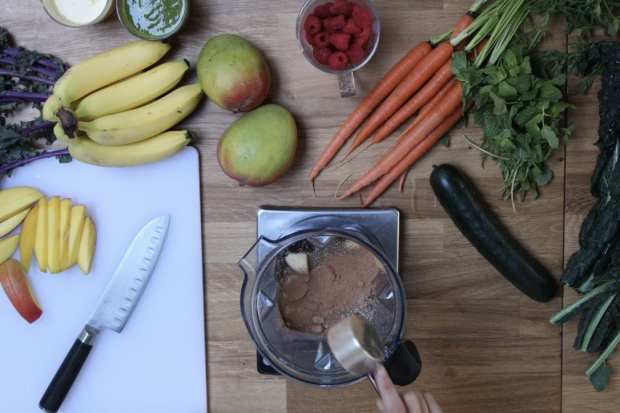Smoothie Order-Ahead Via Robotics

Food preparation is going to the robotic overlords, with entrepreneurs tackling the tasks of making products such as smoothies with the help of automation. Take Blendid, which Co-Founder Vipin Jain defined in a PYMNTS interview as a fully autonomous “robotic kiosk that prepares food on demand.” Jain describes the company’s offerings as having an array of benefits such as protein, fiber, probiotics and antioxidants. The technology was just deployed at the University of San Francisco (USF), and Jain sees it coming to food service environments such as college and company cafeterias along with supermarkets, airports and health clubs (in essence, public places where people go and expect food).
To place an order for one of the company’s smoothie blends, diners can use a tablet at a kiosk or a mobile app. In the latter case, consumers can load the mobile app and choose the location where they want the company’s products. They can then look at the menu, and the company offers blends such as the Green Warrior (kale, banana, blueberry, apple juice, kefir, chia) and the Tropical Twist (mango, banana, coconut water). Consumers can browse through each blend and read the product’s nutrition profile. They can also customize beverages (within certain bounds set by the company) and the nutrition profile for the blend will change as consumers go through this process.
Once consumers customize an order, they can arrive at a payments screen and tap into Apple Pay or Google Pay. (They can also input a credit card directly as an alternative.) Consumers can then say they want an order as soon as possible or set a date and time for pickup. At USF, the company will have brand ambassadors on hand to help consumers pick up their drinks if they have any doubts or confusion when it comes time to retrieve their orders. When it comes to visualizing smoothie making, Jain sees the process as breaking down a recipe into a series of steps.
With food preparation, one might take many different ingredients and complete an operation: Ingredients might be blended, grilled, poured or steamed, for instance. And that is how Jain conceptualized the device. The machine has many different dispensers which store different types of ingredients from solids to liquids and superfood powders ranging from bananas to flax. It also has a prep table with three blenders as well as a delivery system that can bring the drinks to a pickup window once prepared. Technology ties it all together. “Blendid is a very sophisticated advanced robotics system,” Jain said.
Last year, the company unveiled a Blendid station at Plug and Play, which an announcement at the time described as “the world’s largest startup innovation platform in Sunnyvale.” Jain described the company’s arrival at USF, however as the first commercial deployment. He said consumers are excited by the machine. “It is so well received,” Jain said. He also noted that the machine is a natural fit for students as they know technology and they are comfortable with technology. USF, however, is not the only campus to become home to robotic innovations in recent times.
The Robotics Market
At George Mason University, which is thousands of miles away from USF in Northern Virginia, students, staff and faculty can order drinks and food with the help of robotics firm Starship Technologies and food service company Sodexo. By using a Starship Deliveries app for iOS and Android devices, they can order food from quick-service restaurant (QSR) concepts from Starbucks, Blaze Pizza and Dunkin’ as well as Sodexo’s on-campus branded grocery store called 2nd Stop.
Diners choose a selection of food and drink items within that app and drop a pin at a location for delivery. A robot then makes the trek across campus and diners can monitor its progress via a map. When the robot arrives, a diner can receive an alert to meet the robot and unlock it through an app. Deliveries can happen within 15 minutes or faster and the robot has a payload of 20 pounds. The aim is to serve students, who may be open to using the technology and free up time in their busy lives.
Beyond college campuses, robotics has taken hold in food prep (like Blendid). Café X, for instance, uses robotics to prepare cups of coffee. There is Flippy, an automated fast-food burger-flipper, and also Sally the Salad Robot, which has been brought to markets that include hotels and C-stores. And it was reported last year that Little Caesars received a patent for what it called an “apparatus provided for assembling pizza.”
With the help of robotics, then, food preparation — and delivery — on and off campus might be handled with the help of robotics and automation from disruptors looking to provide convenience to customers hungry for food ranging from pizza to smoothies.
